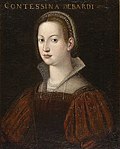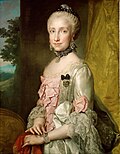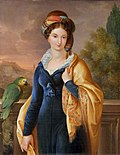Margravine of Tuscany
House of Bonifacii, 812–931
| Picture | Name | Father | Birth | Marriage | Became Consort | Ceased to be Consort | Death | Spouse |
|---|---|---|---|---|---|---|---|---|
| The names of the wives of Boniface I are not known. | ||||||||
 | Bertha | - | - | - | 828 husband's accession | 834 husband's deposition | - | Boniface I |
| The names of the wives of Aganus are not known. | ||||||||
 | Anonsuara | - | - | - | 847 husband's accession | - | Adalbert I | |
 | Rothilde of Spoleto | Guy I of Spoleto (Widonids) | - | 863 | 886 husband's death | - | ||
 | Bertha of Lotharingia | Lothair II of Lotharingia (Carolingian) | 863 | 895/898 | 10/15 September 915 husband's death | 8 March 925 | Adalbert II | |
 | Marozia of Tusculum | Theophylact I, Count of Tusculum (Tusculani) | 863 – 8 March 925 | 925 | 929 husband's death | 932/937 | Guy | |
House of Arles, 931–1001
| Picture | Name | Father | Birth | Marriage | Became Consort | Ceased to be Consort | Death | Spouse |
|---|---|---|---|---|---|---|---|---|
 | Willa of Burgundy | Rudolph I of Burgundy (Elder Welf) | - | 912 | 931 husband's accession | 936 husband's deposition | after 936 | Boso |
 | Willa of Spoleto | Boniface I of Spoleto | - | around 936 | 936 husband's accession | 13 February 962 husband's deposition | - | Hubert |
 | Judith | - | - | - | 961 husband's accession | 21 December 1001 husband's death | - | Hugh |
House of Bologna, 1004–1011
- Interregnum 1011–1014
Unknown House, 1014–1027
| Picture | Name | Father | Birth | Marriage | Became Consort | Ceased to be Consort | Death | Spouse |
|---|---|---|---|---|---|---|---|---|
 | Waldrada | Guglielmo | - | - | 1014 husband's accession | 1027 husband's death | - | Rainier |
House of Canossa, 1027–1115
| Picture | Name | Father | Birth | Marriage | Became Consort | Ceased to be Consort | Death | Spouse |
|---|---|---|---|---|---|---|---|---|
 | Richelida of Bergamo | Giselbert II, Count of Bergamo | late 10th century | before 1015 | 1027 husband's accession | after 1034 | Boniface IV | |
 | Beatrice of Bar | Frederick II, Duke of Upper Lorraine (Ardennes-Bar) | 1017 | 1037 | 6 May 1052 husband's death | 18 April 1076 | ||
- Interregnum 1115–1120
House of Scheiern, 1120–1127
- Interregnum 1127–1135
House of Sponheim, 1135–1137
- None
House of Welf, 1137–1139
| Picture | Name | Father | Birth | Marriage | Became Consort | Ceased to be Consort | Death | Spouse |
|---|---|---|---|---|---|---|---|---|
 | Gertrude of Süpplingenburg | Lothair III, Holy Roman Emperor (Süpplingenburg) | 18 April 1115 | 29 May 1127 | 1137 husband's accession | 20 October 1139 husband's death | 18 April 1143 | Henry |
House of Attems, 1139–1152
House of Welf, 1152–1173
| Picture | Name | Father | Birth | Marriage | Became Consort | Ceased to be Consort | Death | Spouse |
|---|---|---|---|---|---|---|---|---|
 | Uta of Calw | Godfrey of Calw, Count Palatine of the Rhine (Calw) | 1115/1120 | by January 1133 | October 1152 husband's accession | 1160 their son became Margrave | 1197 | Welf VI (1st reign) |
| 11/12 September 1167 husband's accession | 1173 husband lost the March | Welf VI (2nd reign) | ||||||
- Interregnum 1173–1195
House of Hohenstaufen, 1195–1197
| Picture | Name | Father | Birth | Marriage | Became Consort | Ceased to be Consort | Death | Spouse |
|---|---|---|---|---|---|---|---|---|
 | Irene Angelina | Isaac II Angelos (Angelos) | 1177/1181 | 25 May 1197 | 1197 husband ceased to be Margrave | 27 August 1208 | Philip | |




















